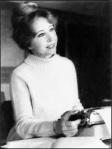A new design has surfaced that engages signage, lighting and much more within the pedestrian walkways in the U.K. Read the full article on The Crosswalk of the Future, posted by Adele Peters, FastCompany (Oct. 2017).

A new design has surfaced that engages signage, lighting and much more within the pedestrian walkways in the U.K. Read the full article on The Crosswalk of the Future, posted by Adele Peters, FastCompany (Oct. 2017).


Anais Nin, essayist and famous for her diaries published in 1960 shares her perspective on why artists create in a short video clip, Why I Write (2:00) shared during a 1974 radio series, produced by KPFK 90.7 FM, in Los Angeles.
Joe Berry is Vice President for Entrepreneurship with Greater Owensboro Economic Development in Northwestern Kentucky stated that “…Creative placemaking is the marriage of the arts and economic development. When you have a localized arts and culture –you have something that no one else has… an environment that is different than anywhere else.” Learn more about his interview with Pilar McKay on behalf of Next Generation Rural Creative.

Image retrieved offline from Think with Google
Rainworks (video 2:00) encourages whimsy in the shared spaces. See how this inexpensive treatment can bring inspiration and wonder to the streets in your city.
I am captivated by the concept of human-scale (or larger) art that aspires to incorporate found or re-purposed items; which I refer to as environmental public art. Patrick Dougherty ‘s “Stickwork” comes to mind. He weaves a story using found items that are intended to be returned to the land after a period of time.

Monk’s Cradle by Tommy O’Laughlin
James Doran-Webb uses drift wood to create masterful, public art displays along bodies of water. In the image below, each horse is comprised of approximately 400 pieces of driftwood varying in size.

Sometimes threats, outside the control of a community can bring surprising unification such as in the case of a recovering from a natural disaster. In 2010 Christchurch, New Zealand was hit with an earthquake that resulting in $40 billion in damages. As a temporary rebuilding effort to unite residents and visitors in public spaces, the Blue Pallet Pavilion was erected. According to ArchitectureAU, “The idea was stimulated by two separate absences: a lack of small-to-medium-sized venues and community centers in the central city for live music, performances and other events, and a severe lack of imaginative post-quake temporary architecture in Christchurch. Gap Filler’s original concept was a temporary pavilion made from pallets, with basic amenities (lighting, audiovisual equipment, a stage). A small team of architecture graduates, mentored by a range of professionals, turned this concept into a fully developed design that could make it through a building consent process (March, 2014).”
Now after years of service to the community the space is being deconstructed to make way for another development opportunity.


Lights can be an powerful medium in a public art display. It is used to evoke a mood, highlight a key architectural feature, tell a story and so much more. Embrace temporary and shine the light on your community. Here are two examples:

From December 11 to February 2, the Luminous Pathway in the heart of the city is transformed into an illuminated futuristic wheat field created by a multidisciplinary team led by the Kanva architecture firm. Learn more...

Located inside the Virginia Avenue parking garage south of Maryland St., “Swarm Street” by Acconci Studio of New York (pronounced “Uh-KON-chee”), is an interactive light environment that the creators compare to swarms of fireflies. More than 1,000 LED-lights will be embedded below you in the pavement plus another 1,000 will be installed in an open steel-framework above you. Movement from users on the trail will activate light sensors that “swarm” around the user and follow the movement through the space. Read the full post.

In 2009, a resident of Hudson WI built a tribute to his mother-a former school teacher. Todd Bol created a miniature box filled with free books. His willingness to connect innovative ideas of others, create a shared space, and give back to his community became the cornerstone of the Little Free Library movement. In partnership with Rick Brooks, they created an enterprise model that has supported the installation of over 40,000 registered libraries in all 50 states and 70 counties around the world.
What developed out of Bol’s interests created a revolutionary way to support literacy, bring together neighbors and connect visitors/tourists to a community.
How have you made a positive mark on your community, region, state or the world?

I love it when I visit a community and spot something unexpected in the shared spaces. In this instance it was a poetry embedding in a sidewalk at a local, community park.

Life is a JOURNEY.
Choose well those with whom you travel!
by Loraine Heath